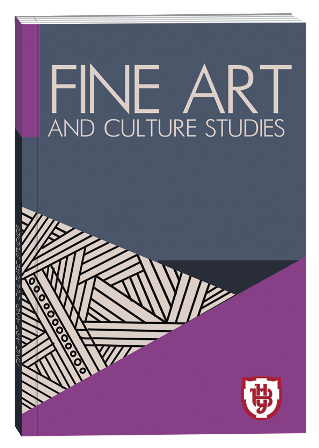ОСОБЛИВОСТІ РИТМІКИ ТА МЕЛОДИКИ ЗНАКОВИХ УКРАЇНСЬКИХ ВІЙСЬКОВИХ МАРШІВ
DOI:
https://doi.org/10.32782/facs-2023-5-2Ключові слова:
військовий марш, пунктирний ритм, мелодика, оркестрова музика, музична фраза, тетрахордиАнотація
Мета дослідження полягає у виявленні особливостей метро-ритмічних фігур та мелодичних моделей відомих українських військових маршів у музичних формах в яких реалізується художньо-естетичний задум. Методологія роботи поєднує порівняльно-історичний та теоретико-музикознавчий методи. Наукова новизна. У статті вперше здійснено аналіз метро-ритмічних елементів та мелодичних моделей маршових військових композицій: «Запорізький марш», січовий марш «Гей там на горі січ іде», «Ми гайдамаки», марш українських націоналістів «Зродились ми великої години», «За Україну». Вперше прослідковується функціонування висхідних тетрахордів у маршовій композиції «Ми гайдамаки», що призводять до музично-словесної кульмінації, на відміну від маршової пісні «Гей, там на горі Січ іде» з низхідними тетрахордами та октавним стрибком. Зроблено висновок, що всі ці маршові військові музичні твори об’єднані єдиним задумом налаштувати воїнів на мужній стоїчний лад. З’ясовано, що у «Запорізькому марші» ключова роль надана пунктирному ритму, який надає творові емоційного характеру, підкреслюючи при цьому елементи синкопованого ритму у першій частині. Акцентовано увагу на тому, що даний марш написаний у дводольному розмірі. Його ритмічний малюнок та розмірений темп не видозмінюються протягом цілого твору. Кожний виклад музичного матеріалу «Запорізького маршу» вже з перших нот тримає слухача в напруженні, підготовлюючи до наступних тактів. Чергування різних тривалостей 8:16:2 та синкопованого ритму надають твору емоційного характеру. Визначено особливості переплетення висхідних та низхідних обернень тризвуків у «Запорізькому марші», які виділяються перегуками з октавними стрибками, вказуючи на бадьористий характер композиції. У марші українських націоналістів «Зродились ми великої години» досліджено дванадцятитактовий виклад музичного матеріалу в чотиридольному розмірі мінорної тональності, що вже з першої фрази розвиває мелодичну висхідну лінію твору. Низхідні квінтові стрибки пунктирного ритму у ньому підготовлюють більш плавні висхідні квартові стрибки, що надають мелодиці бравурного забарвлення. Встановлено той факт, що незважаючи на невелику кількість фраз обрамлених пунктирним ритмом, все ж відчувається дух маршовості, акцентуючи окремі слова, що підкреслюють їхнє значення гостротою звучання.
Посилання
Гуцал В.О. Партитура Запорізького маршу. Київ: Спілка, 1995. 48 с.
Денисюк І.С. Музична імпровізація: від учителя музики до учня. Мистецтво та освіта, 2016. № 2. С. 18–21.
Діброва Г.В. Роменський кобзар Мусій Олексієнко. Народна творчість та етнографія,1991. № 2. С. 84–94.
Діброва Г.В. Кобзар Мусій Олексієнко-учитель Євгена Адамцевича та один із авторів «Запорізького маршу» . Часопис української історії, 2012. Вип. 22. С. 30–34
Іванов Л.Ф. Деякі питання розвитку духової оркестрової музики в західних країнах: художня творчість і тенденції соціокультурного руху сучасності. Державна академія керівних кадрів культури і мистецтв, 2020. № 2. С. 2–7.
Радчук Н.І. Роль пісні у військово-патріотичному вихованні козачат. Педагогічні науки: теорія, історія, інноваційні технології, 2014. №7(41). С. 346–355.
Ріпецький С.С. Українське січове стрілецтво. Нью-Йорк: Червона калина, 1956. 244 с.
Роговська Є.В., Рутецький В.В. Оркестр народних інструментів. Навчально-методичний посібник, 2014. С. 1–220.
Скрипник Г.В. Військова музика. Українська музична енциклопедія. Т.1:[А-Д] Київ: ІМФЕ НАНУ, 2006. С. 370–373.
Стрілецькі пісні /Упорядник Оксана Кузьменко. Львів: Інститут народознавства НАН України, 2005. 640 с.
Чіхрадзе Ш. Г. Еволюція маршу в історії музичної культури. Всеукраїнська науково-методична конференція: Військово-диригентська майстерність, культорологічні та художньо інтерпретаційні аспекти. Львів, 2008. С. 34–38.
Salley T. Sound-off! An Introduction to the Study of American Military Marching Cadences. Masters Theses, 2015. P. 1–52.
htpp://doi.org/10.7275/6949713
Hadley E. St. Roch Military Marches in Wallonia: Memory, Commemoration and Identiti. Quidditas, 2020. № 41. P. 182–206.
Zimmerman W., Lever E. Speed Marching in Military Boots: The Walk-To-Ran Transition Speed and Vertcial Graund Reaction Forces. International Jornal of Sport and Exercise Medicine, 2022. № 1. Р. 1–6. htpp://doi.org/10.23937/2469-5718/1510214







